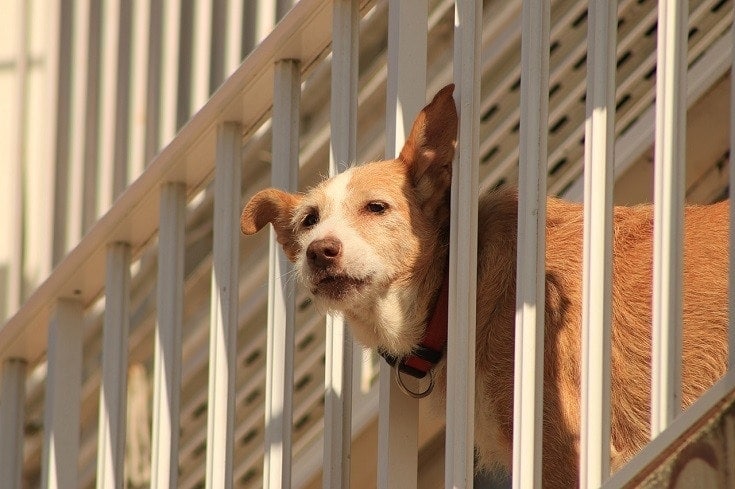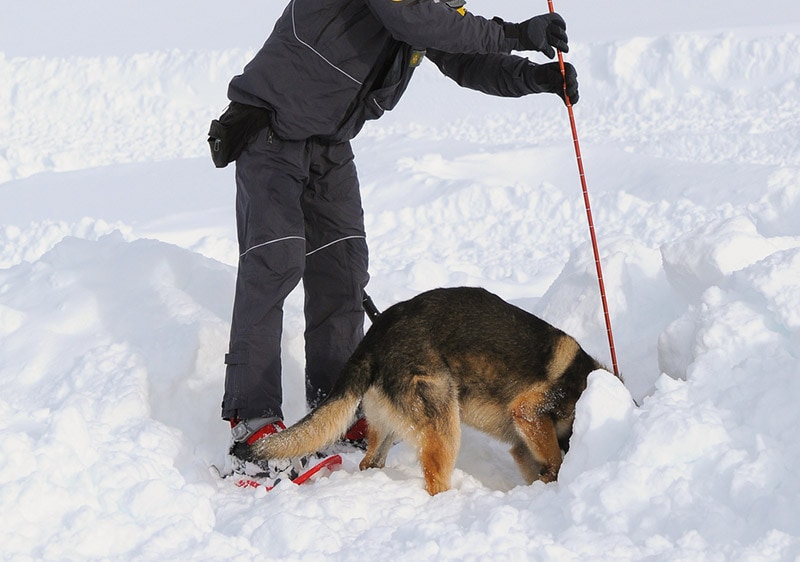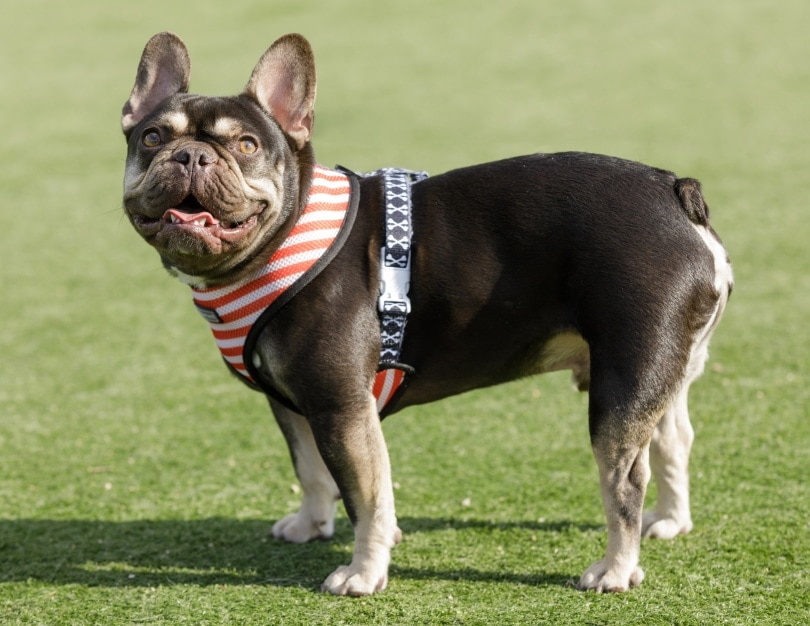How to Dog Proof Balcony Railings — 8 Great Ways
Updated on

For those who live in densely populated cities, living space can be tight, and outdoor areas are often limited to patios or balconies. City-dwelling dog lovers may want their pups to enjoy fresh air on the balcony but worry about how to do it safely.
Balcony railings are meant to keep people contained but not necessarily dogs that could easily slip through or get their heads stuck. If you’re a dog owner with a balcony, here are eight great ways to dog-proof your balcony railings.
The 8 Ways to Dog-Proof Balcony Railings
1. Safety Netting

| Materials needed: | Commercial safety net, zip ties, measuring tape, scissors or knife |
| Difficulty: | Moderate |
If you have a smaller dog, one of the biggest dangers of a balcony is them squeezing through the railings and falling. There are several methods available to help prevent that from happening. One is to purchase a commercial safety netting product.
Many of them are meant to protect small children from falling, but pet-specific products are also available. You’ll need to measure your balcony railing first to make sure you buy a suitable net and cut it to size if needed. Try zip ties or something similar if the net doesn’t come with materials to attach it to the railings.
2. Chicken Wire
| Materials needed: | Chicken wire, wire cutters, measuring tape, wire or zip ties |
| Difficulty: | Moderate |
For more energetic pups who love to chew, you’ll need a more robust option to dog-proof your balcony railings. Chicken wire is a relatively inexpensive material to consider. It’s available at most home improvement stores or online retailers.
The wire is light enough for an easy installation but sturdy enough to withstand chewing. Again, you’ll need to take measurements before buying the wire to ensure you get a long enough roll. Use wire cutters to snip the chicken wire down to size and attach it to the balcony railings with zip ties or wire. Be careful about leaving any sharp edges exposed that could cut you or your dog.
3. Plexiglass Panels

| Materials needed: | Plexiglass panels, zip ties, measuring tape, drill (optional) |
| Difficulty: | Easy-moderate |
Attaching plexiglass panels to your balcony railings is a simple but more expensive way to dog-proof them. The clear panels will preserve your view off the balcony but will also decrease the airflow and breeze that reaches you.
The panels are usually easy to find for sale at home improvement stores and can be attached with zip ties. If they don’t already have holes, you can easily drill your own. Plexiglass panels keep pets and kids safe from falling and can also keep toys and other small objects from dropping onto the street or the neighbor’s balcony down below!
4. Bamboo Fence
| Materials needed: | Bamboo privacy screen, zip ties or wire, measuring tape |
| Difficulty: | Moderate |
If you prefer a little more privacy on your balcony and need to dog-proof it, installing a bamboo privacy screen might be the solution to both problems. Bamboo is light and eco-friendly and is a good option for smaller balconies. You can purchase a shorter fence if you care less about privacy but want to dog-proof your railings.
For the installation, you can use wire or zip ties.
5. Collar Bumpers
| Materials needed: | Collar bumper |
| Difficulty: | Easy |
This option may qualify slightly more as dog-proofing your dog than the balcony railings, but we wanted to mention it because it may be the best choice for some people. A commercial collar bumper looks like a mini-inner tube. It extends far enough of your dog’s neck that even if they can fit their head through the railing, the bumper will keep the rest of their body from following suit.
It’s a better option for small dogs and not necessarily as safe as physically blocking off the railings. However, it’s easy and relatively inexpensive. For those who cannot use a physical barrier, perhaps because their homeowner’s association forbids it, these collars may be the simplest solution.
6. Move Furniture
| Materials needed: | Another person |
| Difficulty: | Easy |
You should probably consider this method whether or not you also physically block off the railings because it eliminates a safety issue for pets and kids. If you have furniture on your balcony, ensure it’s positioned far enough from the railing that your dog can’t use it as a springboard to take flight.
If your patio is too small to keep the furniture back, consider keeping your pet on a leash while you’re outside or provide a taller barrier, such as a bamboo privacy screen.
7. Create a Separate Space

| Materials needed: | Dog fence or playpen, artificial grass (optional), bowls, toys, bed |
| Difficulty: | Moderate |
Another option for dog-proofing your balcony is to create a space within the space for your dog to frolic. This provides an extra layer of protection for your dog by placing them behind another barrier, away from the railing.
If you have a large balcony, you could build a mini-yard for your dog, with artificial grass surrounded by a pet fence or playpen. Add toys, chew objects, food and water bowls, and a comfy bed for your dog. They won’t even miss having the run of the balcony if you make their space exciting enough!
8. Supervision
| Materials needed: | A trustworthy human |
| Difficulty: | Easy |
The simplest and most effective way to dog-proof your balcony railings is to supervise your pup when they are outdoors. Never leave your dog on the balcony when no one is home. Truthfully, it’s safest never to let your dog play on the balcony if you aren’t out there.
Even if they don’t try to escape, there is the danger of sudden wind gusts blowing small dogs around.
Other Potential Hazards on a Balcony

To truly dog-proof your balcony, there are a few other hazards to watch out for besides the railings.
If you are growing any plants on the balcony, ensure they are all non-toxic to dogs. The ASPCA maintains a list of safe plants you can consult before making a new purchase. Watch out for fertilizers or pesticides that could also be toxic to your dog.
If you use your balcony for storage, ensure any chemicals or toxic substances are secured away from your dog. Keep your dog protected from the elements, no matter the season. That means providing shade and water during the hot summer and limiting your dog’s time outdoors. In the winter, dress your dog in a sweater or jacket if they are short-haired and avoid outside time in bad weather.
Conclusion
Keeping a dog in a small space takes more work and planning than a house with a yard. The first step is choosing a dog that matches well with apartment life. It doesn’t always have to be a small dog, but energetic larger breeds or noisy-by-nature pups like hounds or Huskies probably aren’t the best choice.
Make sure you’re prepared for the commitment of walking and exercising your dog regularly if you don’t have the luxury of a yard for them to play in. Many dogs wind up in shelters because their owners cannot care for them in a smaller space or a landlord kicks them out for damage to the property.
See also:
Featured Image Credit: taniadimas, Pixabay












